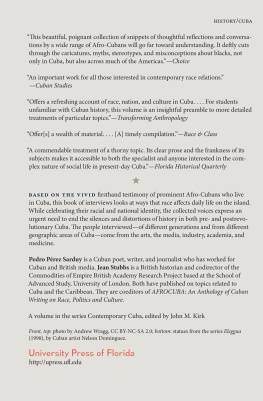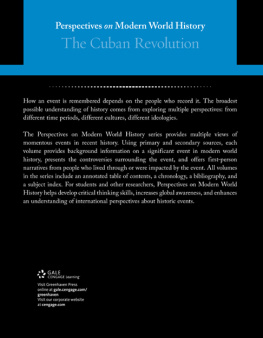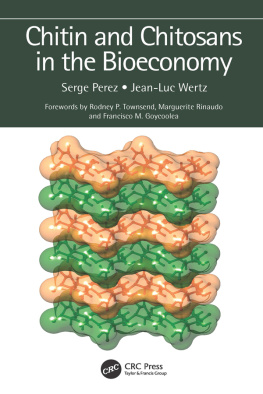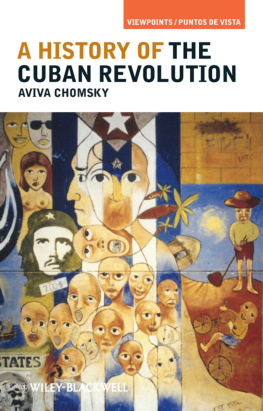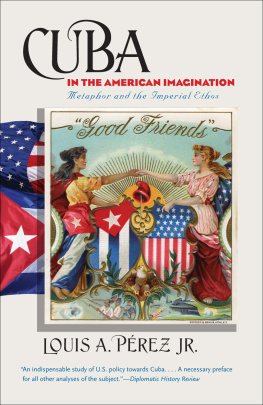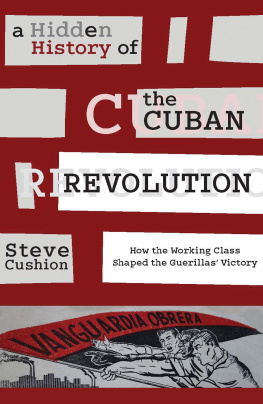Pérez - The structure of Cuban history: meanings and purpose of the past
Here you can read online Pérez - The structure of Cuban history: meanings and purpose of the past full text of the book (entire story) in english for free. Download pdf and epub, get meaning, cover and reviews about this ebook. City: Chapel Hill;Cuba, year: 2013, publisher: University of North Carolina Press, genre: Art. Description of the work, (preface) as well as reviews are available. Best literature library LitArk.com created for fans of good reading and offers a wide selection of genres:
Romance novel
Science fiction
Adventure
Detective
Science
History
Home and family
Prose
Art
Politics
Computer
Non-fiction
Religion
Business
Children
Humor
Choose a favorite category and find really read worthwhile books. Enjoy immersion in the world of imagination, feel the emotions of the characters or learn something new for yourself, make an fascinating discovery.

The structure of Cuban history: meanings and purpose of the past: summary, description and annotation
We offer to read an annotation, description, summary or preface (depends on what the author of the book "The structure of Cuban history: meanings and purpose of the past" wrote himself). If you haven't found the necessary information about the book — write in the comments, we will try to find it.
The structure of Cuban history: meanings and purpose of the past — read online for free the complete book (whole text) full work
Below is the text of the book, divided by pages. System saving the place of the last page read, allows you to conveniently read the book "The structure of Cuban history: meanings and purpose of the past" online for free, without having to search again every time where you left off. Put a bookmark, and you can go to the page where you finished reading at any time.
Font size:
Interval:
Bookmark:
THE STRUCTURE OF CUBAN HISTORY
2013 The University of North Carolina Press
All rights reserved
Designed by Richard Hendel
Set in Quadraat, Block, and Scala Sans types
by Tseng Information Systems, Inc.
Manufactured in the United States of America
The paper in this book meets the guidelines for permanence and durability of the Committee on Production Guidelines for Book Longevity of the Council on Library Resources.
The University of North Carolina Press has been a member of the Green Press Initiative since 2003.
Library of Congress Cataloging-in-Publication Data
Prez, Louis A., 1943
The structure of Cuban history : meanings and purpose
of the past / Louis A. Prez Jr.
pages cm.
Includes bibliographical references and index.
ISBN 978-1-4696-0692-7 (cloth : alk. paper)
ISBN 978-1-4696-0886-0 (ebook)
1. CubaHistory. 2. National characteristics, Cuban. 3. CubaHistoryRevolution, 18951898Influence. 4. Collective memoryCuba. 5. MemoryPolitical aspectsCuba. I. Title.
F1760.P473 2013
972.91dc23 2013008288
17 16 15 14 13 5 4 3 2 1
For GLADYS MAREL GARCA-PREZ
For all the many years of collaboration and friendship
How does one tell the story of a country
whose history is far larger than its size?
Los cubanos: Bretn es un beb (2008)
Tacn Theater, ca. 1870
Liberation Army camp, ca. 1898
Welcome extended to U.S. troops by the inhabitants of a Cuban village, 1898
Rest in Peace: Here lies the sovereignty of Cuba
The deplumed rooster: Senator Orville Platt and President William McKinley offering independence to the Cuban people
The United States as a boar devouring Cuban independence
The Cuban people as Prometheus betrayed by the United States
History hovering: The looming presence of the prceres standing in judgment of the conduct of public affairs of the republic
Conrado Massaguer, Martyrs of the patria
Conrado Massaguer, My God! The Dead always end up so all alone!
Veterans of the 1895 war for independence (mambises) in 1968
Fidel Castro in Santa Clara, January 1959
Headline of the Havana Post announcing the arrival of Fidel Castro in Havana on January 8, 1959
Advertisement welcoming the arrival of the liberators in Havana, January 7, 1959
One-year anniversary commemorative issue of the newspaper Hoy, emphasizing the revolution as historical continuity
Representation of continuity of the Cuban revolution with the mambises of the nineteenth century
Headline from the newspaper Hoy, January 19, 1960, affirming Fidel Castros pronouncement, To defend the Revolution is to defend national independence
Caricature: History of the reactionary clergy in Cuba
Wall mural: Faithful to Our History
Poster commemorating the anniversary of the July 26 attack on the Moncada barracks and the invocation of the Protest of Baragu
Debts of gratitudepersonal and professionalhave accumulated over the many years this book has been in preparation: first and foremost with the staffs of libraries and archivesthe librarians, the bibliographers, the archivists, the curatorswithout whose assistance the completion of this book would have been impossible. The reference staff of Davis Library at the University of North Carolina at Chapel Hill generously contributed time and expertise to the completion of this book, especially Tommy Nixon and Beth Rowe. Geneva Holliday and the staff in the Interlibrary Loan office have been nothing short of spectacular in their ability to locate and obtain materials published over the last 150 years. Teresa Chapa and her staffmost notably Rebecca Huckabyhave provided sustained support all through the multiple phases of research and writing. I have also received invaluable assistance from the staffs at the Library of Congress, particularly in the Hispanic Division and the Manuscript Division, as well as the staffs of the National Archives in Washington, D.C., the National Archives in London, the Robert W. Woodruff Library at Emory University, the Rare Book and Manuscript Library at Columbia University, Special Collections at the University of Florida Library, the New-York Historical Society, and the New York Public Library.
Nor would the research necessary to complete this book have advanced very far without the supportoften under difficult circumstancesof the staffs and directors of archives and libraries in Cuba. A special debt of gratitude is acknowledged here to the Archivo Nacional de Cuba, particularly to Julio Lpez Valds and director Martha Ferriol Marchena. The hospitality of Nuria Gregori Torada, director of the Instituto de Literatura y Lingistica, and her staff facilitated consultation of important serial collections. I received the utmost professional courtesy from Eugenio Surez Prez and Elsa Montero and access to important research materials in the office of Asuntos Histricos del Consejo de Estado. At the Biblioteca Nacional Jos Mart, I received the unfailing assistance of director Eduardo Torres-Cuevas. I am deeply indebted to Miguel Barnet and Nancy Morejn of the Unin de Escritores y Artistas de Cuba for the generosity of support during the final years in which the research for this book was completed.
This book would not have taken the form it has without the collaboration of friends and colleagues who, in the course of the last ten years, in different settings and on different occasions, offered thoughtful counsel and insightful comments, often in the form of hours of conversations and at other times by way of written communicationsexchanges that provided an opportunity to develop many of the arguments advanced in this book. In this regard, I owe much to Mara del Carmen Barcia, Mara Cecilia Bermdez Garca, Soraya Castro Mario, Ambrosio Fornet, Orlando Garca, Rafael Hernndez, Jorge Ibarra, Flix Masud-Piloto, Jos Vega Suol, Jos Viera Linares, Oscar Zanetti, and the late Francisco Prez Guzmn. They shared knowledge and experience, offered insights, and brought relevant research materials to my attention. The manuscript benefited from the comments and suggestions made by Susan Fernndez, Cornelia Waterfall, Allen Welles, and James Woodard, for which I am enormously appreciative. A special thanks to Eduardo Roca Salazar (Choco), who graciously provided permission to use his painting Gente y bandera for the dustjacket of the book. The Research and Study Leave program of the College of Arts and Sciences and the Department of History at the University of North Carolina at Chapel Hill allowed me to complete the writing of the manuscript in a timely fashion. I am, lastly, most appreciative of the attention given to the manuscript by Dorothea Anderson, whose splendid copyediting contributed to improving the book.
Elaine Maisner, senior executive editor at the University of North Carolina Press, provided sustained support for the idea of this project. She engaged the premise of the book and offered encouragement through the years of its writing.
Deborah M. Weissman listened critically and read assiduously the formulations of many of the ideas that sustain the narrative on the pages that follow. The process allowed for the refinement of some arguments and the abandonment of others. This too was vital to the way the ideas ebbed and flowed and the form in which the arguments eventually converged into the final draft of the manuscript.
It is almost impossible to imagine how this book would have been completed without the many years of collaboration provided by Fidel J. Requeijo, who gave of his time, technical knowledge, and street smartsin so many different ways and on so many different occasionsto enable the research to come to a successful conclusion.
Next pageFont size:
Interval:
Bookmark:
Similar books «The structure of Cuban history: meanings and purpose of the past»
Look at similar books to The structure of Cuban history: meanings and purpose of the past. We have selected literature similar in name and meaning in the hope of providing readers with more options to find new, interesting, not yet read works.
Discussion, reviews of the book The structure of Cuban history: meanings and purpose of the past and just readers' own opinions. Leave your comments, write what you think about the work, its meaning or the main characters. Specify what exactly you liked and what you didn't like, and why you think so.




